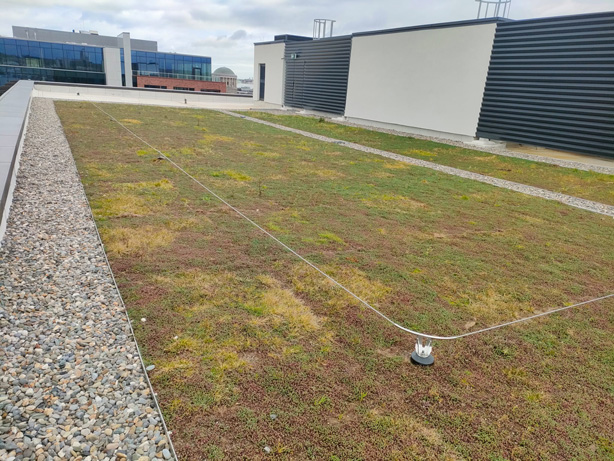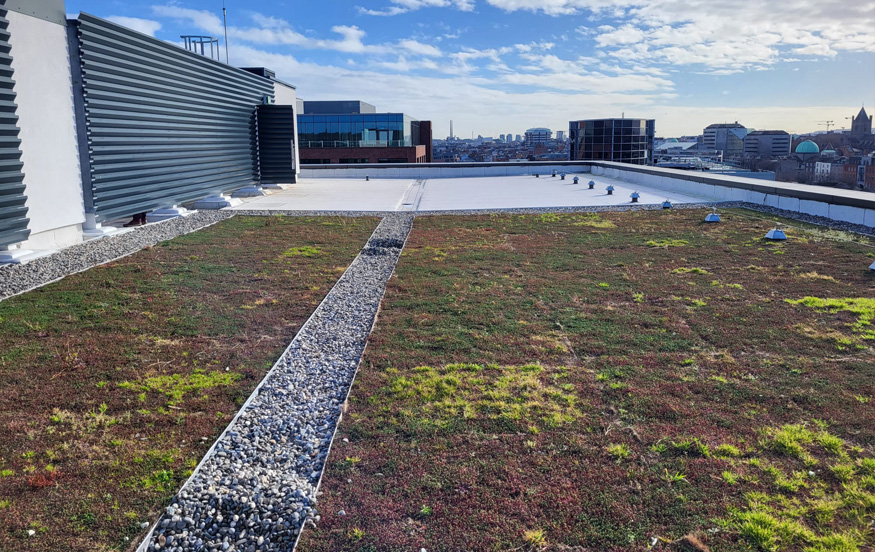With the UK government setting a target of net zero carbon emissions by 2050, procuring sustainable building materials has become more important than ever before.
Mastic asphalt is well known for being tough, durable and long-lasting, but what is perhaps less well known is that it is one of the most sustainable and greenest building materials currently available.
More and more specifiers, facilities managers, building owners and roofing contractors are choosing mastic asphalt for a wide range of green roof applications – from schools to hospitals, office buildings to apartment blocks. Whether intensive or extensive, biodiverse or brown, it is critical that green roofs are built on a solid waterproofing foundation.
Recognised for its environmental performance and aesthetic properties, a green roof system laid with a mastic asphalt waterproofing system enhances the environment, controls storm water run-off and reduces noise and heat transmissions by upgrading the acoustic and thermal performance of a roof. When contractors use mastic asphalt for a green roof system, it eliminates the need for root barriers, which may well have been necessary had a substitute material been used.
 Green Roofing Applications
Green Roofing Applications
Green roofing was recognised at the recent Mastic Asphalt Council (MAC) Awards 2023 in London. The winner of the Development and Hybrid Project of the Year was John Fetherston Roofing for the Haymarket project completed in Dublin which featured a green roof area.
The Smithfield district of Dublin is being regenerated and John Fetherston Roofing completed the Haymarket project as part of the regeneration works. Several IKO mastic asphalt systems were specified for various roof areas. The main roof comprised 1,400m2 and involved the installation of IKO’s Permaphalt mastic asphalt system, and there was also a section where an IKO Extensive Green Roof was installed.
With a shallow soil layer supporting moss and grass, the green roof system was chosen to enhance the client’s sustainability credentials, reduce storm water run-off, to support the wildlife habitat, improve the air quality and to protect the waterproofing membrane from UV degradation. Furthermore, there was an additional terrace roof area, whereby mastic asphalt waterproofing was used as part of a paving system.
Mastic asphalt has one further advantage over other types of waterproof membrane – it is carbon neutral – a massive bonus for any building owner anxious to show their green credentials and, when it has reached the end of its useful life, it can be recycled or used as roof screed, minimising the impact on the environment.
Carbo Saving Case Studies
MAC manufacturer member IKO has been involved in many CarbonZero projects across the UK, where the net carbon footprint of projects is entirely offset using internationally approved carbon credits, which means for every tonne of mastic asphalt made, IKO is helping to fund environmental and humanitarian causes.
One example is Westminster Cathedral, the seat of the Cardinal Archbishop of Westminster and the Mother Church for Roman Catholics in England and Wales. In 2015 the existing mastic asphalt was renewed on the roof of the cathedral and during the works some 35 tonnes of mastic asphalt was installed, equating to 5.5 tonnes of CO2 offset.
IKO’s CarbonZero mastic asphalt solution has also been used to renovate Tower Bridge, one of London’s most iconic landmarks which is used by thousands of people every day. MAC contractor member Infallible Systems installed over 400 tonnes of mastic asphalt, equating to 50.11 tonnes of CO2 offset.
A major project has also been completed at Four Squares Estate in Southwark, whereby IKO was asked by Keepmoat and Southwark Council to investigate issues relating to the existing access walkways. It was agreed that mastic asphalt would be used for the refurbishment, along with screed repairs and new expansion joints. During the works some 1,400 tonnes of mastic asphalt was applied and in terms of impact, this is the equivalent of 218.4 tonnes of CO2 offset.
This article featured within the September 2023 edition of RCi magazine – click here to view the article.

